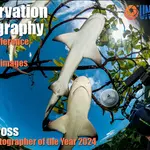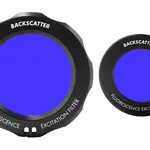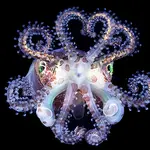Review: Backscatter Mini Flash with Optical Snoot
By Morten Bjorn Larsen
About a year ago I decided that it was time for me to get a decent snoot system. I had previously only tried some homemade snoots with limited success. The closest I got to something that worked, was PVC tubes mounted on my flash, but it really only worked with wide angle.
I had read about Backscatter’s new Mini Flash with an optical snoot several times on the net and thought it sounded interesting. I also contacted other underwater photographers with more snoot experience than me, who all praised the new mini flash with snoot from Backscatter.
If we had not been in the middle of a pandemic when I decided to buy the Backscatter snoot system, being a Scandinavian, I would probably have prioritized saving up for a dive trip somewhere warm. As David Salvatori, an award-winning Italian underwater photographer wrote to me: “Buy it now, if you wait, you will spend the money on a dive trip when we are free to travel again.” So, at last, I contacted Lars Kirkegaard from Fotografit about purchasing the mini flash and snoot.
Flash + Snoot
The system consists of two parts, the first one, as the name suggests, is a mini flash/strobe. The second part is an optical snoot that is mounted directly on the mini flash. The flash alone can probably be of good use for compact cameras, but I don’t believe it’s powerful enough for big wide angle scenes with a bigger camera system. When the snoot is mounted, it’s perfect for macro for all camera systems.
A LED focus light on the flash makes it possible to easily see exactly where the flash spot will hit. The focus light has three power settings that make it possible to see the focus spot even in broad daylight. It takes one click on the on/off bottom to shift between the power settings of the focus light.
The flash has six power settings which are controlled on a turn-able knob like most other flashes. Two aperture cards adjust the diameter of the light beam. One is with round holes in it and the other comes with oval holes.
I find it quite easy (with a little practice) to shift between the different diameter light beams in the cards while shooting. It is also possible to rotate the snoot while shooting, which gives various possibilities of shaping the light beam, mostly while using the oval card though. The flash can only be used with fiber optic cables.
In the field
At the time when the package from Fotografit arrived, the restrictions in Denmark allowed only coast diving with a maximum of five divers. Coast diving in and around Copenhagen, where I live, means green water that most of the year offers poor visibility. I always try to see these green/poor viz conditions as good practice for underwater photography. And with new toys, I’m less concerned about the available water quality and more excited about just getting wet and trying out the new toy. I was strong-minded that I wanted to test the different functions that the system offers. Until late summer my dives were local coast diving only, and at the beginning of October, we went on a long weekend trip to Sweden, where I also got to play with the snoot.
Different beam sizes: The first feature that I wanted to try was switching between the different beam/diameter sizes in the aperture card with the circular holes. To begin with, I struggled a little with aiming and hitting my subjects, but on the second dive I started to get my aim right and all the real fun began. One day on a relaxed dive at the end of a fjord north of Copenhagen, I found a goby chilling in a sponge. I slowly approached it and started to shoot its face upfront while I tried the different apertures in the card. I was pleased that the goby stayed still and didn’t seem to care about me, so I could shoot it in the exact same place, to get a feeling of how it looks with different diameters of light in the “same” image.
Separation of the subject: The next thing I tried was separating a subject from the seabed. I often feel my images are looking messy with two strobes when the sandy or muddy seabed is lit up behind the subject. I found the 60mm macro lens very useful combined with the snoot when trying to make a clean separation between subject and seabed so that everything around the subject is pitch black.
Oval Card: One of the most exciting things to try for me was the oval aperture card. I thought the oval light beam would probably work best with subjects that fit in an oval spotlight. Therefore I joined a couple of nudibranch experts on a dive north of Copenhagen. They quickly showed me some nudibranchs (Polycera quadrilineata) living on kelp leaves These nudibranchs are very small, and for that reason, I was using my 105mm macro lens fitted with a +10 SubSee dioptre. I was only using the smallest aperture in the oval card, to be able to see the spot when shooting super macro. It was really good fun trying to get it right and it makes me look forward to someday be in a place with even more nudibranchs in a wider range of size.
Framing: I have also been playing using the snoot on animals hiding in cracks or holes. My idea was to light a little bit of the crack/hole as a frame around the animal and leave the rest of the image black.
Wide angle: When purchasing a snoot system it will for most shooters be with the purpose of using it for macro. But I felt like giving it a shot with wide angle. As earlier mentioned, the visibility in Denmark can often be quite poor, and for that reason, backscatter can be hard to avoid when using normal strobes. I have also seen images from other underwater photographers, where they on purpose have lit up only a small area of the frame to get a certain effect in the composition.
So I combined a fisheye lens, mini-dome, and of course the mini flash with a snoot. We dove at the wreckage, where I know that sea anemones (Metridium dianthus) can be found, so I could try to only light up one of them in a wide angle scene. If you look closely, particles can be seen in the light beam from the snoot. On the way back from the wreckage we stumbled across some jellyfish dancing in the sunbeams in shallow water. Just for fun, I tried to aim the snoot at the top of a jellyfish to resemble sunbeams hitting the jellyfish.
Squids on a night dive: When we went to Sweden our main goal was to find squids in a certain fjord. October is the best month to find these tiny squids. Now that I was getting more comfortable using the snoot, I felt I was ready to give it a go on a night dive to around 30 meters. On normal blackwater dives, a 60mm macro lens combined with twin strobes is the most common setup used. But the visibility and the fact that these squids often swim close to a very soft sandy seabed make up for a lot of dirt/particle removal in post-processing, if you have used one or two strobes. Therefore, I wanted to take the chance to see if I could hit the squids with only the light from my snoot. We had three-night dives and on the first dive, I did manage to hit the squids with only the snoot beam. But it was difficult to be accurate and avoid lighting up the seabed just below. But on the next two dives, it started to work out very well. The few particles that can be seen are easy and not very time-consuming to get rid of in post-processing. I used a Sola focus light on the lowest power setting to be able to see the squids through the viewfinder in my camera. I had also set the focus light in the mini flash to the most powerful output, and in that way, I could see the focus light from the mini flash clearly even though the Sola was turned on at all times. The light from the Sola can’t be seen in the images shot at 1/250 sec f/29 ISO200.
Wider diameter: In the two images below, it could have been nice to be able to shoot with a wider snoot diameter – maybe some sort of tube to mount directly on the mini flash. The first is a wide angle image of an edible crab where I could not light up the whole crab, even though I removed the aperture card and therefore shot with the widest possible diameter. The second example is taken with a 60mm macro lens of a crab eating a dead jellyfish, here I would have loved to have a little bigger spotlight. But with that said, I’m really happy that I bought this super creative toy – it is so versatile and allows you to adjust and play with the setup on your dives.
About the Author
Morten Bjorn Larsen is a Danish Copenhagen-based 39-year-old uw-photographer, who works as a bricklayer. Diving came by chance to Morten, who had never really considered getting a certificate. However, on a travel in 2002 his girlfriend convinced him to take the course on Phi Phi Islands in Thailand, and a new world opened up to him.
The passion for underwater photography came in 2007 when Morten was given a Sea & Sea 860G compact camera and a tiny YS27 extern flash for a wedding gift.
Since 2010 Morten has worked as a freelance photographer and writer for the Scandinavian dive magazines DYK , Sportsdykkeren, and Dykking. It has taken Morten to the Philippines, Lanzarote, Sardinia, Norway, and Corsica. Mortens articles and photos have also been published in DIVER (UK), SCUBA (UK) Sportsdykaren (Sweden), Scubalife (Croatia), and Unterwasser (Germany).
FTTC Disclosure
The items reviewed were purchased by the reviewer.
Tagged: backscatter mini flash, morten larsen, review
Read More Wetpixel.com




